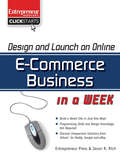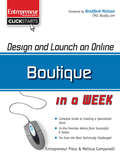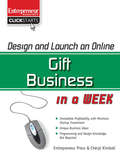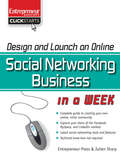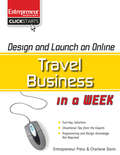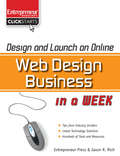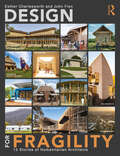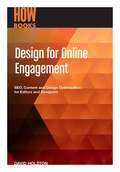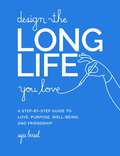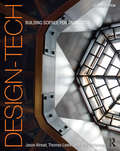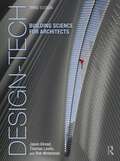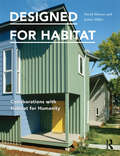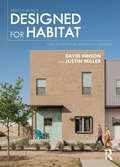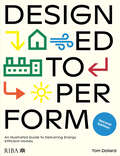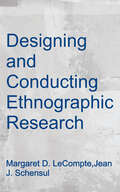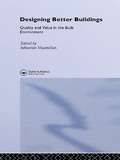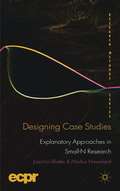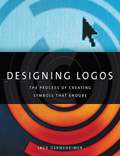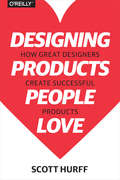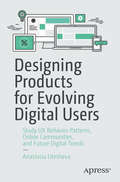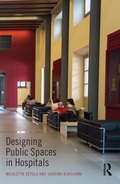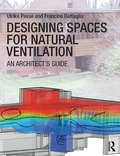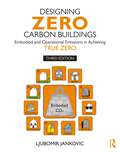- Table View
- List View
Design and Launch an E-Commerce Business in a Week
by Jason R. RichHave you fantasized about your own retail store-selling your own specialty items, showcasing unique products or better promoting existing products? Or have you dreamed of working from home, setting your own hours and still making great money? Today's technology makes it easier than ever to take your retail dreams to the world's largest marketplace-the Internet. In just days, you can build your own eCommerce website, reach potential customers by the millions, process orders 24/7 and accept payments from all over the world-with no technical background or graphic design skills! Design a professional eCommerce site using inexpensive, turnkey solutions from established companies like Google, Yahoo! and Go Daddy that require no programming or graphic design knowledge Create content and online deals that capture shoppers and keep them coming back Use surefire online tools that work 24/7 to handle payments and accept orders Drive traffic using Search Engine Optimization and other marketing and advertising techniques Skillfully handle inventory, order fulfillment, customer service and all other operations The world's largest marketplace is at your fingertips...take advantage of it!
Design and Launch an Online Boutique in a Week
by Melissa CampanelliWouldn't you love to own your own trendy boutique-a hot spot that showcases your unique style? Do you daydream about selling your signature products to high-end shoppers? Your dream is just a few clicks and one week away! Whether your taste is classy and elegant or hip and unique, there's a spot for you in today's largest retail center-the internet. In just days, build your posh, online boutique selling luxury, designer goods or your own upscale, signature products. Learn how to handle and showcase inventory, reach affluent shoppers, fulfill orders, accept payments and so much more-using turnkey solutions that require no technical skills! Design a professional specialty-retail site using inexpensive, turnkey solutions from established companies like Google, Yahoo! and Go Daddy that require no programming or graphic design knowledge Create eye-catching content that captures elite shoppers and keeps them coming back. Use foolproof online tools that work 24/7 to handle payments and accept orders. Drive traffic using search engine optimization, new media marketing and other marketing and advertising techniques. Skillfully handle inventory, order fulfillment, customer service and all other operations. Stylish, unique, one-of-kind-turn your personal taste into a successful, online store--in just a few clicks and a few days!
Design and Launch an Online Gift Business in a Week
by Cheryl KimballAre you creative? Interested in taking your favorite hobby or inventive attitude to a new, more profitable level? Would you like to work from the comfort home, making money around the clock? Thanks to today's turnkey technology, in just a few clicks and a few days you can build a virtual gift store selling your favorite items to millions! Choose from today's hottest online gift businesses, including food, pets, hobbies, home goods, and holiday items, or debut and sell your signature goodies. In just one week, break into the billion-dollar gift industry, create a fully-functioning website, tap into millions of eager online shoppers, and more! Design an attractive, multi-functional website using inexpensive, turnkey solutions that require no programming knowledge Tap into the newest gift trends, and choose your specialty and services Use easy, automated solutions that work 24/7 to accept orders and handle payments Skillfully manage inventory, order fulfillment, customer service, and all other operations Create repeat shoppers with online deals and promotions Drive traffic using search engine optimization, social marketing, and other online marketing techniques
Design and Launch an Online Social Networking Business in a Week
by Julien SharpAre you a virtual social butterfly? Captivated by the buzz of new media? Interested in setting the online social scene for others? And making a profit doing so? Tap into the millions of MySpace users and Facebook friends to create your own specialized social site! In just seven days, identify your network niche; develop an inviting, interactive website; drive traffic and membership; build profitable online advertising relationships; and more! Design an attractive, interactive social networking website using inexpensive, turnkey solutions that require no programming knowledge Define your community and set the tone Offer interactive features including profile pages, member search options, media add-ons, and more Generate traffic and membership using search engine optimization, viral and social marketing, and other techniques Cash in on your site with proven, revenue-generating solutions Use included resources to stay on the cutting-edge
Design and Launch an Online Travel Business in a Week
by Charlene DavisLove travel? Do you enjoy discovering new adventures, finding the best deals, and making plans? Would you like to work with people around the world from the comfort of home? In the trillion-dollar, worldwide travel and tourism industry, it's easier than ever to tap into your enthusiasm for travel and turn it into your next paycheck. In just one week, discover how to establish your business, create an attractive and functional website, master online marketing tools, partner with qualified providers, and more! Design an attractive, multi-functional website using inexpensive, turnkey solutions that require no programming knowledge Tap into the newest travel trends, and choose your specialty and services Set policies and procedures that satisfy your and your clients' needs Use easy, automated solutions that work 24/7 to handle requests and payments Drive traffic using search engine optimization, social marketing, and other online marketing techniques Boost profits by expanding your offerings
Design and Launch an Online Web Design Business in a Week
by Jason R. RichAre you an online artist ready to take your passion to the next level? Would you love your creative talent to be on showcase for millions to see and buy? Thanks to today's amazing technology, it's easier than ever to tap into your passion and turn it into your next paycheck! In just a few days and a few clicks, you can build a successful online web design business selling your creative services. Discover how to easily develop your own website, effectively showcase your work, promote yourself to a worldwide audience, generate new clients, better service existing clients, and more! Design an attractive, business website using inexpensive, turnkey solutions from established companies like Google, Yahoo! and Go Daddy that require no programming knowledge Create a killer online portfolio that captures new clients Use easy online tools that work 24/7 to handle requests and payments Drive traffic using search engine optimization and other marketing and advertising techniques Boost profits by expanding your specialty or your business
Design for Fragility: 13 Stories of Humanitarian Architects
by Esther Charlesworth John FienThe demand is now urgent for architects to respond to the design and planning challenges of rebuilding cities and landscapes being destroyed by civil conflict, (un)natural disasters, political instability, and poverty. The number of people fleeing their homes and being displaced by such conflict now totals almost 100 million. Despite the massive human and physical costs of these crises, the number of architects, planners, and landscape architects equipped to work with disaster and development professionals in rebuilding in the aftermath of conflict, floods, fires, earthquakes, typhoons, and tsunamis remains chronically low. Design for Fragility expands the nascent, but rapidly growing field of humanitarian architecture by exploring 13 design responses to such conflict and displacement across 11 countries, including Australia, Bangladesh, Fiji, India, Iran, Pakistan, and the USA. Linked to this displacement is the systemic poverty that often lingers from previous colonial territories and eras, in which many of the featured projects in the book are located. This book follows Charlesworth’s Humanitarian Architecture: 15 Stories of Architects Working After Disasters (Routledge 2014), which analysed the role for architects in exercising ‘spatial agency’ while designing shelter and settlement projects for communities after conflict and disaster. Since that time, the humanitarian architecture movement has expanded globally with the prominence of design agencies including the MASS Design Group and Architecture Sans Frontières (ASF) International. Design for Fragility analyses this role of spatial agency in architecture by addressing diverse conditions of fragility across 13 built projects – from refugee housing in Uganda and an orphanage for teenage girls in Iran to a residential centre in Northern Australia for people with acquired brain injury. Each of the projects profiled in this book explore: The experiences and perceptions of fragility – or precarity – that provided a design challenge and directed the particular spatial response. The specific typology of the project, whether that be a housing, health, children’s, or a First Nations project. The personal values that influenced the architects to work on humanitarian/community projects and how consultation occurred with diverse and often contested project stakeholders. The experiences of the design team as well as project managers, occupants, and donors of the built project, exploring what they deemed successful about the project, and what, if any, were its limitations. Beautifully designed with over 150 illustrations, this practical and inspiring book is for architects, landscape architects, design educators, humanitarian and development aid agencies that are involved, or seeking to be part, of future disaster mitigation and reconstruction strategies and projects, globally.
Design for Online Engagement
by David HolstonThe world changes on a daily basis. People's needs change, political, technical and social thinking changes, and your site will need to change to reflect the world around it. On a daily basis you need to be aware of any number of elements including strategy, brand, search, content, design, code, and measurement. And you need to be constantly checking to make sure you're on course. The Web never sleeps, and neither should your site.
Design for Online Engagement: SEO, Content and Design Optimization for Editors and Designers
by David HolstonThe world changes on a daily basis. People's needs change, political, technical and social thinking changes, and your site will need to change to reflect the world around it. On a daily basis you need to be aware of any number of elements including strategy, brand, search, content, design, code, and measurement. And you need to be constantly checking to make sure you’re on course. The Web never sleeps, and neither should your site.
Design the Long Life You Love: A Step-by-Step Guide to Love, Purpose, Well-Being, and Friendship
by Ayse BirselDesign a long life full of love, purpose, well-being, and friendship, at any age, using the creative tools of award-winning product designer, author, and world's #1 life coach Ayse Birsel.What does it mean to craft the life you want, as you grow older? For industrial designer and author Ayse Birsel, the answer draws on key principles of design—like optimism, empathy, collaboration, open-mindedness, and holistic thinking—as well as the experiences of older people on the pioneering frontiers of long life. Longer life is a thrilling, modern opportunity, and like so many parts of life it needs to be thoughtfully designed. Thinking about a long life is very exciting indeed. It&’s also a new phenomenon. Fifty years ago, living into one&’s seventies was considered the mark of a long life. Today, seventy feels young, eighty feels normal, and ninety is within reach. Birsel believes this new horizon of life is as important and exciting as the invention of moving pictures. Or that of automobiles, or even space travel. Her point is, when a change this big happens, innovation follows.This book is for everyone who is interested in defining their long life, using design thinking tools. It&’s an interactive book with exercises that will help you think creatively by asking you to visualize your life. It is full of insights learned from wise people who have lived the longest. It is organized into the four themes of Love, Purpose, Well-Being, and Friendship, and contains insights that will help you love better, find purpose, practice well-being, and make friends. Drawing on Birsel&’s year-long codesign research with older people, Design the Long Life You Love offers readers of all ages—from those in their twenties and thirties just starting out, to those in mid-life looking for a change, to those in later life who are the experts for us all—thought-provoking questions, exercises for self-exploration, and interviews with innovative entrepreneurs and thought-leaders to guide them on their own journeys of crafting the next phase of life. Focusing on four keys areas—Love, Purpose, Well-Being, and Friendship—this book pairs life lessons from people who've lived the longest with design tools to help you plan your own long life, whether you're looking ahead to retirement, a home post-children, or starting a new project that makes you come alive.Playfulness is key to creating a long life, and readers will find that reflected in this joy-filled book. Whimsical, two-color drawings, illustrated interviews with thought-leaders, and interactive exercises will put you in the mindset of a designer as you foster creativity and explore what your own long life can look like. When it comes to our lives, we are our own innovators—so let's begin to learn how to do just that.Welcome to Design the Long Life You Love!
Design-Tech: Building Science for Architects
by Thomas Leslie Jason Alread Robert WhiteheadDesign-Tech is an indispensable, holistic approach to architectural technology that shows you in hundreds of drawings and tables the why as well as the how of building science, providing you with a comprehensive overview. In this expanded edition, measurements and examples are listed in both metric and imperial units to reflect the global reality of architectural practice. The authors also address digital fabrication, construction documentation, ultra-high-rise structures, and zoning codes. And there's more in-depth coverage of structural design and greater emphasis on environmental forces. Numerous case studies demonstrate real-world design implications for each topic, so that you can integrate technical material with design sensibilities. Short chapters explain each topic from first principles in easy-to-reference formats, focusing on what you need to know both at the drawing board and in future discussions with engineers, contractors, and consultants. This new edition incorporates material from continuing curricular experimentation in the SCI-TECH sequence at Iowa State University, which has been recognized with awards and funding from the American Institute of Architects, the U.S. Green Building Council, and the National Council of Architectural Registration Boards.
Design-Tech: Building Science for Architects
by Jason Alread Thomas Leslie Rob WhiteheadThe third edition of Design-Tech provides an indispensable, holistic resource for integrating building technologies into critically designed, performance-based architectural projects. The book’s format follows the developmental stages of a typical architectural project; it provides a step-by-step process for addressing and integrating building sciences from first principles of human comfort, materials, structures, and environmental systems to advanced construction systems and measures of building performance. Short chapters incorporate easy-to-understand information with hundreds of useful illustrations, tables, and references that explain the why as well as the how of building science. The content focuses on what designers need to know in the studio to create sustainably designed, integrated buildings, and it prepares them for future discussions with engineers, contractors, and consultants.The updated format builds a coherent framework for integrated project design studio development, necessary for all contemporary accredited schools of architecture. Chapters build upon critical project information from schematics toward technical integration. New chapters emphasize performance-based design strategies including sustainable design values, critical schematic planning, enhanced building envelope design strategies, and advanced performance systems. Enhanced visualization of schematic design strategies helps explain sustainable design standards, code compliance, and structural schematics, and throughout, the third edition focuses on contemporary issues such as embodied carbon, heavy timber construction, life cycle costs, and long-term performance.This will be a must-read for all architecture students looking for an accessible guide to building science.
Designed for Habitat: Collaborations with Habitat for Humanity
by Justin Miller David HinsonIf you're looking for ways to give back to your community, then this book, the first to profile thirteen projects designed and built by architects and Habitat for Humanity, will help. Detailed plans, sections, and photographs show you how these projects came about, the strategies used by each team to approach the design and construction process, and the obstacles they overcame to realize a successful outcome. The lessons and insights, presented here will aid you, whether you're an architect, architecture student, Habitat affiliate leader, or an affordable housing advocate. Located all across the United States, these projects represent the full spectrum of Habitat for Humanity affiliates, from large urban affiliates to small rural programs. These cases illustrate a broad range of innovative approaches to energy performance, alternative construction strategies, and responses to site context. And each house demonstrates that design quality need not fall victim to the rigorous imperatives of cost, delivery, and financing.
Designed for Habitat: New Directions for Habitat for Humanity
by Justin Miller David HinsonDesigned for Habitat: New Directions for Habitat for Humanity presents 12 new projects designed and built via collaborations between architects and Habitat for Humanity®. The ways in which we think about affordable housing are being challenged by designers and not-for-profit housing advocates such as Habitat for Humanity and its affiliates. The projects chronicled in this book consider home affordability through the lens of monthly homeownership expenses, energy efficiency and residential energy use, and issues of designed resilience to natural events ranging from aging and accessibility concerns to natural disasters and climate change. New to this edition, the projects reflect new approaches to building scale, construction technology, energy and affordability, and design and context. Illustrated with over 100 color images, the case studies include detailed plans and photographs to show how these projects came about, the strategies used by each team to approach the design and construction process, and the obstacles they overcame to realize a successful outcome. The lessons and insights presented will be a valuable resource, whether you’re an architect, an architecture student, a Habitat affiliate leader, or an affordable housing advocate.
Designed to Perform: An Illustrated Guide to Delivering Energy Efficient Homes
by Tom DollardHow do we ensure sustainable buildings perform as intended? The performance gap between predicted and actual energy use in new homes has been identified as key problem by government and industry experts. This updated edition is an illustrated practical design guide to delivering better energy performance in all types of new build homes. It introduces readers to the concept of the performance gap and highlights clear issues and solutions to help architects improve their detailing at design stage. The book: Features annotated details with photos taken from live construction sites Includes accessible practical guidance for busy practitioners Raises construction quality and performance of new homes Promotes the case for more architect supervision throughout the construction process A new chapter features innovative low carbon building methods, including hempcrete blocks, clay blocks and straw bale. All information has been updated to reflect the latest data with fresh details and technologies.
Designing And Conducting Ethnographic Research: An Introduction
by Margaret D. LeCompte Jean J. SchensulThe Ethnographer's Toolkit series begins with this primer, which introduces novice and expert practitioners alike to the process of ethnographic research, including answers to questions such as who should and can do ethnography, when it is used most fruitfully, and how research projects are carried out from conceptualization to the uses of research results. Written in practical, straightforward language, this new edition defines the qualitative research enterprise, links research strategies to theoretical paradigms, and outlines the ways in which an ethnographic study can be designed. Use Designing and Conducting Ethnographic Research as a guide to the entire Toolkit or as a stand-alone introduction to ethnographic research.
Designing Better Building: Quality And Value In The Built Environment
by Sebastian MacmillanDesign is widely recognised as the key to improving the quality of the built environment. This well-illustrated book comprises 15 chapters written by leading practitioners, clients, academics and other experts, and presents the latest thinking on what design quality is and how to achieve it. For design practitioners and their clients alike, the book provides evidence to justify greater focus on, and investment in, design. It summarises the benefits that arise from good design - such as, civic pride in the urban environment, the stimulation of urban regeneration, corporate identity, occupant productivity and health in offices, improved learning outcomes in schools, better patient recovery rates in hospitals, as well as reduced environmental impact. And it illustrates these benefits through case study examples. Eight chapters focus on case studies of exemplary buildings in particular sectors - offices, schools, housing, and hospitals - and explain why and how they came to be designed, and the design qualities they exhibit.
Designing Case Studies
by Joachim Blatter Markus HaverlandThe authors explore three ways of conducting causal analysis in case studies. They draw on established practices as well as on recent innovations in case study methodology and integrate these insights into coherent approaches. They highlight the core features of each approach and provide advice on each step of the research process.
Designing Logos: The Process of Creating Symbols That Endure
by Jack GernsheimerHow to design great logos, step by step by step. * Lavishly illustrated with 750 color images * How-tos, case studies, and detailed analysis of well-known logos What makes a logo good? What makes it bad? What makes it great? The entire process of logo design is examined, from the initial client interview to brainstorming, from first presentation to delivery of the final standards manual. Through 750 color illustrations, classic logos are analyzed, and readers will learn a thirteen-point system for measuring the effectiveness of any logo. Learn about the uses of positive and negative space, balance, color, and typography; follow intriguing case studies; discover how to make effective presentations to clients. Designers, marketing and branding specialists, educators, and students everywhere need this definitive guide to creating great logos.
Designing Products People Love: How Great Designers Create Successful Products
by Scott HurffHow can you create products that successfully find customers? With this practical book, you’ll learn from some of the best product designers in the field, from companies like Facebook and LinkedIn to up-and-coming contenders. You’ll understand how to discover and interpret customer pain, and learn how to use this research to guide your team through each step of product creation.Written for designers, product managers, and others who want to communicate better with designers, this book is essential reading for anyone who contributes to the product creation process.Understand exactly who your customers are, what they want, and how to build products that make them happyLearn frameworks and principles that successful product designers useIncorporate five states into every screen of your interface to improve conversions and reduce perceived loading timesDiscover meeting techniques that Apple, Amazon, and LinkedIn use to help teams solve the right problems and make decisions fasterDesign effective interfaces across different form factors by understanding how people hold devices and complete tasksLearn how successful designers create working prototypes that capture essential customer feedbackCreate habit-forming and emotionally engaging experiences, using the latest psychological research
Designing Products for Evolving Digital Users: Study UX Behavior Patterns, Online Communities, and Future Digital Trends
by Anastasia UteshevaDigital user behavior is evolving at an ever-increasing pace, and predicting future trends is a booming business as a result. Users associate technology with their identities now more than ever, and it is up to you as a product designer to enhance their experience for the better. Designing Products for Evolving Digital Users is a 21st century handbook that helps you do just that. By providing insights that allow you to study UX (user experience) behavior patterns, online communities, and future digital trends, Designing Products for Evolving Digital Users instills confidence and fact-based foundations for your digital creations. Author Anastasia Utesheva expertly teaches you how to account for the way the technology impacts the identity of users and how that identity shifts through ongoing interaction with a product or service. She also brings in important case studies on social media, gaming, eRetail, and more to illustrate past examples of technology’s profound impact on communal and individual identity. Digital product design’s ultimate end goal is end user satisfaction. While a myriad of material is available out there consisting of simple tips and tricks for optimal digital design, Designing Products for Evolving Digital Users is a rare and remarkable title that cohesively accounts for all environmental factors involved. Comprehend how distributed technology impacts creation and negotiation of identity and explore communities that form around digital products. UX designers, futurists, students, and industry veterans alike have an abundance of invaluable learning ahead of them in Designing Products for Evolving Digital Users. What You Will LearnLearn how to design digital products/services that resonate with and transform identity of usersStudy how digital impacts formation of identityConsider how digital technology has impacted our world and implications for future digital trendsWho This Book Is For UX designers, digital product creators, entrepreneurs, educators, philosophy of technology enthusiasts, futurists
Designing Public Spaces in Hospitals
by Nicoletta Setola Sabrina BorgianniDesigning Public Spaces in Hospitals illustrates that in addition to their aesthetic function, public spaces in hospitals play a fundamental role concerning people’s satisfaction and experience of health care. The book highlights how spatial properties, such as accessibility, visibility, proximity, and intelligibility affect people’s behavior and interactions in hospital public spaces. Based on the authors’ research, the book includes detailed analysis of three hospitals and criteria that can support the design in circulation areas, arrival and entrance, first point of welcome, reception, and the interface between city and hospital. Illustrated with 150 black and white images.
Designing Regulatory Policy with Limited Information (Harwood Fundamentals Of Pure And Applied Economics Ser.)
by D. Besanko D. SappingtonExamines policy design when the policy maker in imperfectly informed, focusing on cases where the regulated firm possesses better information about its technology than the regulator.
Designing Spaces for Natural Ventilation: An Architect's Guide
by Ulrike Passe Francine BattagliaBuildings can breathe naturally, without the use of mechanical systems, if you design the spaces properly. This accessible and thorough guide shows you how in more than 260 color diagrams and photographs illustrating case studies and CFD simulations. You can achieve truly natural ventilation, by considering the building's structure, envelope, energy use, and form, as well as giving the occupants thermal comfort and healthy indoor air. By using scientific and architectural visualization tools included here, you can develop ventilation strategies without an engineering background. Handy sections that summarize the science, explain rules of thumb, and detail the latest research in thermal and fluid dynamics will keep your designs sustainable, energy efficient, and up-to-date.
Designing Zero Carbon Buildings: Embodied and Operational Emissions in Achieving True Zero
by Ljubomir JankovicIn this significantly revised third edition, Designing Zero Carbon Buildings combines embodied and operational emissions into a structured approach for achieving zero emissions by a specific year with certainty.Simulation and quantitative methods are introduced in parallel with analogue scale models to demonstrate how things work in buildings. Where equations are provided, this is also explained with common analogue objects, pictures, and narratives. A Zero Equation introduced in this book is not only explained as an equation but also as an analogy with a jam jar and spoons, making the book accessible for a range of audiences. Tasks for simple experiments, exercises, discussion questions, and summaries of design principles are provided in closing lines of chapters.This book introduces new case studies, in addition to an updated case study of the Birmingham Zero Carbon House, applying embodied and operational emissions to assess their status using the Zero Equation. The approach introduced brings about a sense of realism into what true zero emissions mean. Written for students, educators, architects, engineers, modellers, practising designers, sustainability consultants, and others, it is a major positive step towards design thinking that makes achieving zero carbon emissions a reality.
